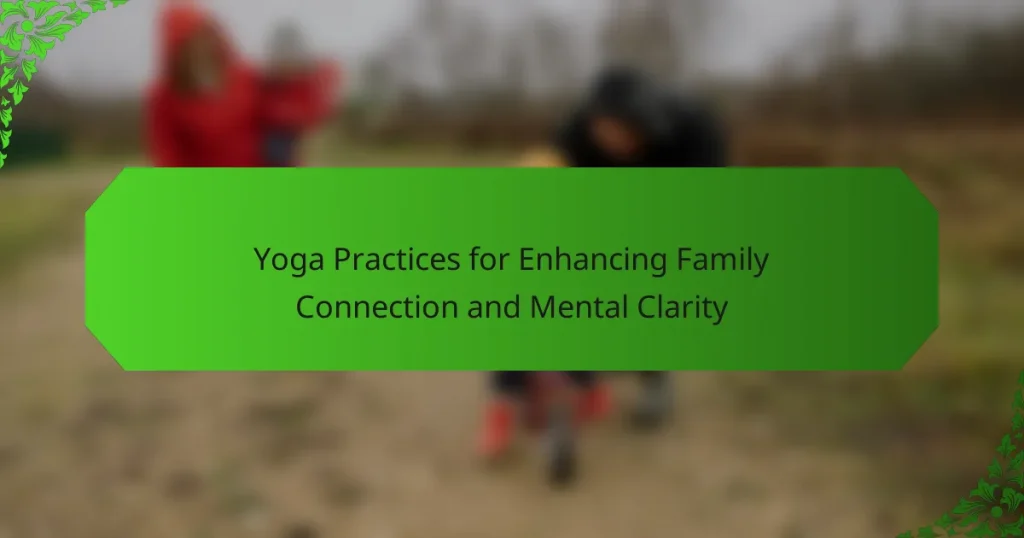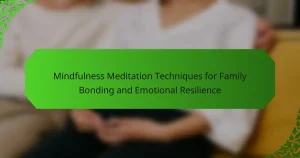Yoga practices can strengthen family connections while enhancing mental clarity. Engaging in yoga together fosters communication and emotional support. Regular sessions reduce stress and improve cognitive function. Incorporating mindfulness techniques nurtures patience and understanding, creating lasting family traditions.
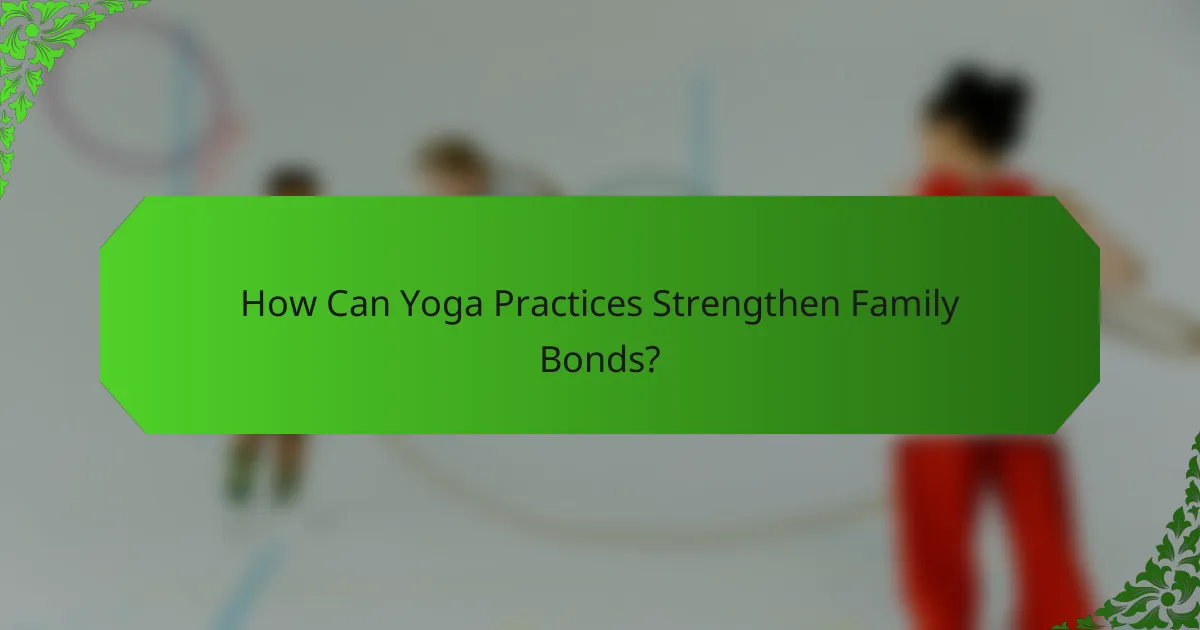
How Can Yoga Practices Strengthen Family Bonds?
Yoga practices can significantly strengthen family bonds by fostering communication and mindfulness. Engaging in yoga together promotes shared experiences and encourages emotional support among family members.
Regular family yoga sessions can enhance mental clarity and reduce stress, benefiting overall family dynamics. Studies indicate that practicing mindfulness through yoga can improve interpersonal relationships, leading to a more harmonious home environment.
Incorporating yoga into family routines nurtures patience and understanding, essential qualities for healthy connections. This practice can also create a unique family tradition, reinforcing unity and shared values.
By prioritising family yoga, families can cultivate lasting memories while enhancing their emotional well-being and connection.
What are the key yoga techniques for family connection?
Yoga techniques for enhancing family connection include partner poses, mindfulness practices, and breathwork. Partner poses encourage teamwork and trust, fostering deeper bonds. Mindfulness practices, such as guided meditation, promote presence and emotional awareness, enhancing communication. Breathwork techniques help regulate emotions, creating a calm environment for family interactions. These practices not only strengthen relationships but also improve mental clarity for all family members.
How can partner yoga enhance communication?
Partner yoga enhances communication by fostering trust and non-verbal connection. This practice encourages participants to be attuned to each other’s movements, promoting empathy and understanding. As partners synchronise their breathing and poses, they develop a deeper awareness of each other’s needs and emotions. This shared experience strengthens bonds and opens channels for honest dialogue. Engaging in partner yoga can lead to improved conflict resolution skills and a more harmonious family dynamic.
What role does group yoga play in family dynamics?
Group yoga enhances family dynamics by fostering connection, communication, and mental clarity. Participating in shared yoga sessions encourages bonding through mindfulness and shared experiences. Families can develop trust and understanding, leading to improved relationships. Moreover, the practice promotes emotional regulation, reducing stress and anxiety among family members, which positively impacts overall family well-being. Engaging in yoga together nurtures a supportive environment, reinforcing family unity and resilience.
What benefits do families experience from practicing yoga together?
Families practicing yoga together experience enhanced bonding, improved communication, and reduced stress. Engaging in yoga promotes mindfulness, fostering emotional connection and understanding among family members. Research indicates that joint yoga sessions can increase empathy and cooperation, contributing to a harmonious family environment. Additionally, regular practice can enhance mental clarity, allowing families to navigate challenges more effectively.
How does yoga promote emotional resilience in families?
Yoga enhances emotional resilience in families by fostering mindfulness, improving communication, and reducing stress. These practices create a supportive environment that strengthens family bonds. Engaging in yoga together promotes shared experiences and emotional understanding. Research shows that families practicing yoga report higher levels of emotional well-being and connection. Regular sessions can lead to improved mood regulation and conflict resolution skills, making families more resilient in facing challenges.
In what ways does yoga foster a sense of belonging?
Yoga fosters a sense of belonging through community engagement, shared experiences, and supportive environments. Group classes create social connections, enhancing family ties and mental clarity. Practicing together encourages communication, trust, and empathy, which strengthens relationships. Additionally, yoga’s inclusive nature allows individuals to feel accepted, fostering a supportive community atmosphere.

What Unique Aspects of Yoga Enhance Mental Clarity?
Yoga enhances mental clarity through mindfulness, breath control, and physical postures. These practices promote focus and reduce stress, leading to improved cognitive function. Mindfulness during yoga encourages present-moment awareness, which sharpens concentration. Breath control techniques, such as pranayama, increase oxygen flow to the brain, enhancing clarity. Additionally, specific postures stimulate blood circulation, supporting mental acuity. Engaging in regular yoga fosters a unique attribute of mental resilience, contributing to sustained clarity over time.
How do specific yoga postures improve focus?
Specific yoga postures enhance focus by promoting mindfulness and reducing distractions. Poses like Tree Pose and Eagle Pose require balance and concentration, which train the mind to stay present. These postures activate the body’s energy centres, improving mental clarity and connection within families. Practicing yoga together fosters communication and strengthens bonds, creating a supportive environment for shared mindfulness. As a result, families can enjoy improved focus and emotional well-being through regular yoga practice.
Which asanas are best for boosting concentration?
Practicing yoga asanas can significantly boost concentration. Effective asanas include Padmasana, Sukhasana, and Balasana, which enhance mental clarity and focus. These poses promote mindfulness and reduce distractions, leading to improved cognitive performance. Regular practice can deepen family connections through shared yoga sessions, fostering a nurturing environment.
How does breathwork contribute to mental clarity?
Breathwork enhances mental clarity by promoting relaxation and focus. It reduces stress, which can cloud thoughts, enabling clearer thinking. Techniques like diaphragmatic breathing increase oxygen flow, improving cognitive function. Regular practice fosters mindfulness, allowing individuals to remain present and attentive.
What unique practices can families incorporate for mental clarity?
Families can incorporate unique yoga practices to enhance mental clarity and connection. Techniques such as partner yoga foster communication and trust. Mindful breathing exercises promote relaxation and focus. Family yoga sessions can create shared experiences, strengthening bonds. Incorporating themed practices, like gratitude yoga, can deepen emotional awareness and connection.
How can mindful breathing exercises be adapted for children?
Mindful breathing exercises can be effectively adapted for children by incorporating playful elements and short durations. Engaging activities, such as pretending to blow up a balloon or imagining they are blowing away clouds, can make the practice enjoyable. Short sessions of 3 to 5 minutes are ideal to maintain their attention and interest. Using visuals, like colourful diagrams or animations, can also enhance understanding. Encouraging children to express their feelings about the exercise fosters emotional awareness and connection.
What are the benefits of family meditation sessions?
Family meditation sessions enhance emotional bonds, reduce stress, and improve communication. These sessions foster mindfulness, allowing family members to connect deeply and share experiences. Studies show that regular practice can lead to increased empathy and understanding among participants. Engaging in meditation together cultivates a supportive environment, promoting mental clarity and emotional resilience.
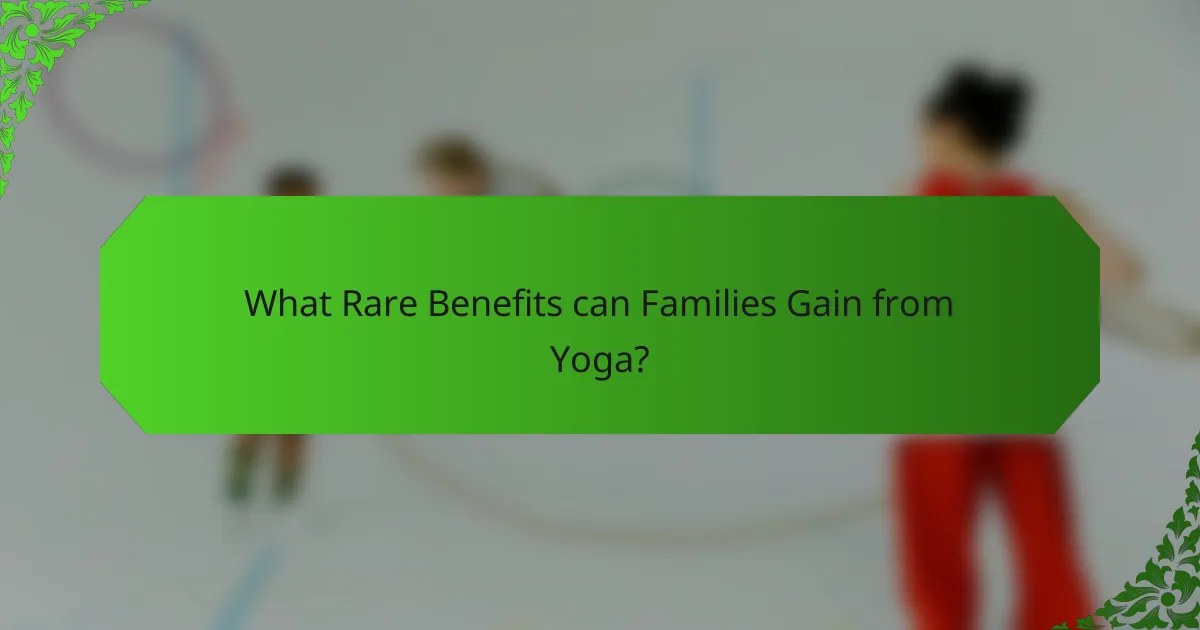
What Rare Benefits can Families Gain from Yoga?
Families can gain rare benefits from yoga, including enhanced emotional resilience and improved communication skills. These practices foster deeper connections and understanding among family members. Engaging in yoga together can lead to unique bonding experiences that promote mindfulness and reduce stress. As a result, families may experience a notable increase in overall harmony and mental clarity.
How can yoga practices lead to unique family experiences?
Yoga practices can create unique family experiences by fostering deeper connections and enhancing mental clarity. Engaging in yoga as a family encourages teamwork and communication, promoting emotional bonding. Shared sessions can lead to memorable moments, where families explore mindfulness together, reducing stress and improving overall well-being. Unique activities, like partner poses or family yoga retreats, can strengthen relationships, making yoga a catalyst for enriching family dynamics.
What uncommon yoga activities can families explore?
Families can explore uncommon yoga activities like partner yoga, acro yoga, laughter yoga, and yoga scavenger hunts. These practices enhance connection and promote mental clarity through collaboration and creativity. Partner yoga fosters trust and communication, while acro yoga builds teamwork and physical strength. Laughter yoga combines humour with traditional practices, reducing stress and increasing joy. Yoga scavenger hunts engage families in a playful exploration of yoga poses in nature, encouraging bonding and mindfulness.
How does yoga influence family creativity and problem-solving?
Yoga enhances family creativity and problem-solving by fostering mindfulness and open communication. Engaging in yoga practices together promotes a shared experience, strengthening emotional bonds. Research shows that families practicing yoga report improved mental clarity, leading to better problem-solving skills. This collective focus encourages innovative thinking and collaboration, making it easier to navigate challenges.
What are the long-term impacts of yoga on family relationships?
Yoga practices significantly enhance family relationships by fostering communication, empathy, and emotional resilience. Regular yoga sessions cultivate mindfulness, allowing family members to connect on a deeper level. This shared experience promotes understanding and reduces stress, leading to healthier interactions. Over time, families practicing yoga together report improved conflict resolution and stronger bonds, reinforcing a supportive environment. The unique attribute of shared mindfulness enhances emotional clarity, benefiting family dynamics in the long term.
How can yoga practices evolve as families grow?
Yoga practices can adapt as families grow by incorporating diverse styles and activities that engage all members. Families can benefit from joint sessions that foster connection, promoting mental clarity and emotional well-being.
As children develop, practices can evolve to include playful elements, such as partner poses or yoga games, enhancing engagement. For example, family yoga classes can introduce storytelling through poses, making sessions enjoyable and educational.
In addition, regular family yoga routines can instill mindfulness habits, benefiting mental health. Research shows that practicing yoga together can improve family dynamics, reducing stress and increasing communication.
Ultimately, the evolution of yoga practices in families can reflect changing needs, creating a nurturing environment that supports growth and connection.
What are the stories of families transformed by yoga?
Yoga practices can significantly transform families by enhancing connection and mental clarity. Families that engage in yoga together report improved communication and emotional bonding. For instance, a study found that regular family yoga sessions foster mindfulness, reducing stress and promoting a supportive environment. Unique attributes, such as tailored yoga routines for different ages, further enhance the experience, allowing members to connect on various levels. As a result, families often experience a profound shift in their dynamics, leading to healthier relationships and increased overall well-being.
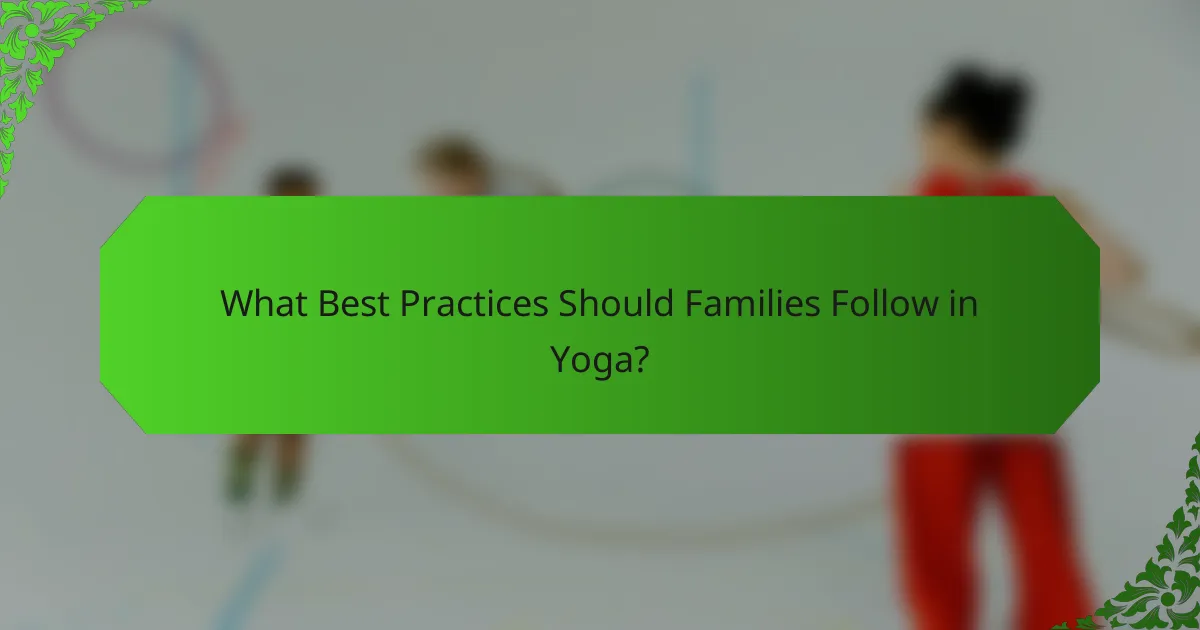
What Best Practices Should Families Follow in Yoga?
Families should practice yoga together to strengthen connections and enhance mental clarity. Regular family yoga sessions foster communication, reduce stress, and promote mindfulness. Engaging in partner poses can build trust and cooperation. Additionally, incorporating breathing exercises helps improve focus and emotional regulation. Setting a consistent schedule for family yoga can further solidify these benefits, creating a shared space for relaxation and connection.
How can families create a consistent yoga routine?
Families can create a consistent yoga routine by setting specific times, choosing engaging practices, and encouraging participation. Start with a designated time each week for family yoga sessions, which fosters commitment. Incorporate various styles, such as gentle yoga or partner poses, to keep everyone interested. Use online resources or apps for guided sessions that appeal to all ages. Lastly, celebrate progress together, reinforcing the mental clarity and connection gained through shared practice.
What common mistakes should families avoid in yoga practices?
Families should avoid distractions, rushing through poses, and neglecting communication during yoga practices. Fostering a mindful environment enhances connection and mental clarity. Establishing a routine can also prevent inconsistencies that disrupt practice. Prioritising quality over quantity in sessions is essential for effective engagement.
What expert insights can enhance family yoga experiences?
Expert insights can significantly enhance family yoga experiences by fostering deeper connections and mental clarity. Incorporating mindfulness practices, such as guided breathing and meditation, can help families engage more fully during sessions. Tailoring yoga poses to accommodate all ages promotes inclusivity and encourages participation. Creating a calming environment with soothing music and natural light can enhance focus and relaxation. Lastly, incorporating family discussions about emotions and experiences post-session strengthens bonds and encourages open communication.
